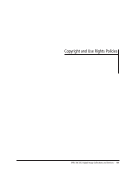SPEC Kit 335: Digital Image Collections and Services · 173
YALE UNIVERSITY
Copyright &Citation Help
http://guides.library.yale.edu/content.php?pid=47735&sid=354470
American Library Association Information on TEACH Act
Stanford University Copyright and Fair Use
Thorough website relating to Fair Use in the educational context.
Columbia University Copyright Advisory Office
Thorough website about the relationship of copyright law and higher education organized by Kenneth
Crews,
North American Coordination Councilon Japanese Library Resources: Image Use Protocol
Guide for using images from Japan for publication.
Creative Commons
"Provides free licenses and other legal tools to mark creative work with the freedom the creator wants it to
carry, so others can share, remix, use commercially, or any combination thereof."
When you need to purchase rights to publish a copyrighted image, look here:
Art Resource
Clearing house for the rights of major European an American museums, archives and collections.
Artists Rights Society (ARS)
Clearing house for the rights of the majority of the artists active in the 20th century.
WATCH File
A database of copyright contacts for writers, artists, and prominent figures in other creative fields.
Citation Guidelines*
Digital images, like text, must be cited when used used in papers, article, books, etc. Don't forget citing a digitized version
of an image is different than citing the original object. A very good guide that includes how to use images is the 2008
edition of Sylvan Barnet's A Short Guide to Writing About Art, which is available through Yale Libraries.
Chicago Manual of Style
The Chicago Manual of Style: Online version of the 15th edition. See chapter 12 for detailed information on artworks.
The Chicago Manual of Style is available also available in print editions at many YUL libraries.
Here is an example of a proper citation for a photograph in Chicago Style. The image was located in the Library of
Congress Prints &Photographs Division online catalog.
Footnote or Endnote
Ann Rosener, "Don't let pretty labels on cans mislead you," 1942, Photograph, Washington
D.C., Library of Congress, Prints and Photographs Division, FSA – OWI Collection,
http://hdl.loc.gov/loc.pnp/fsa.8e10753.
Bibliography
Rosener, Ann. "Don't let pretty labels on cans mislead you," 1942. Photograph. Washington
D.C., Library of Congress, Prints and Photographs Division, FSA – OWI Collection.
http://hdl.loc.gov/loc.pnp/fsa.8e10753 (accessed June 10, 2008).
Additional citation guidelines:
A Manual for Writers of Research Papers, Theses, and Dissertations by Kate L. Turabian is available at numerous
Yale Libraries has ample information in a section called Visual Sources. Turabian style indicates paintings, sculptures,
photographs, and other artworks should only be cited in notes, not bibliographies. Titles of paintings are italicized
while titles of photographs are set in quotation marks.
Examples:
8/7/13 7:35 PM
YALE UNIVERSITY
Copyright &Citation Help
http://guides.library.yale.edu/content.php?pid=47735&sid=354470
American Library Association Information on TEACH Act
Stanford University Copyright and Fair Use
Thorough website relating to Fair Use in the educational context.
Columbia University Copyright Advisory Office
Thorough website about the relationship of copyright law and higher education organized by Kenneth
Crews,
North American Coordination Councilon Japanese Library Resources: Image Use Protocol
Guide for using images from Japan for publication.
Creative Commons
"Provides free licenses and other legal tools to mark creative work with the freedom the creator wants it to
carry, so others can share, remix, use commercially, or any combination thereof."
When you need to purchase rights to publish a copyrighted image, look here:
Art Resource
Clearing house for the rights of major European an American museums, archives and collections.
Artists Rights Society (ARS)
Clearing house for the rights of the majority of the artists active in the 20th century.
WATCH File
A database of copyright contacts for writers, artists, and prominent figures in other creative fields.
Citation Guidelines*
Digital images, like text, must be cited when used used in papers, article, books, etc. Don't forget citing a digitized version
of an image is different than citing the original object. A very good guide that includes how to use images is the 2008
edition of Sylvan Barnet's A Short Guide to Writing About Art, which is available through Yale Libraries.
Chicago Manual of Style
The Chicago Manual of Style: Online version of the 15th edition. See chapter 12 for detailed information on artworks.
The Chicago Manual of Style is available also available in print editions at many YUL libraries.
Here is an example of a proper citation for a photograph in Chicago Style. The image was located in the Library of
Congress Prints &Photographs Division online catalog.
Footnote or Endnote
Ann Rosener, "Don't let pretty labels on cans mislead you," 1942, Photograph, Washington
D.C., Library of Congress, Prints and Photographs Division, FSA – OWI Collection,
http://hdl.loc.gov/loc.pnp/fsa.8e10753.
Bibliography
Rosener, Ann. "Don't let pretty labels on cans mislead you," 1942. Photograph. Washington
D.C., Library of Congress, Prints and Photographs Division, FSA – OWI Collection.
http://hdl.loc.gov/loc.pnp/fsa.8e10753 (accessed June 10, 2008).
Additional citation guidelines:
A Manual for Writers of Research Papers, Theses, and Dissertations by Kate L. Turabian is available at numerous
Yale Libraries has ample information in a section called Visual Sources. Turabian style indicates paintings, sculptures,
photographs, and other artworks should only be cited in notes, not bibliographies. Titles of paintings are italicized
while titles of photographs are set in quotation marks.
Examples:
8/7/13 7:35 PM


































































































































































































